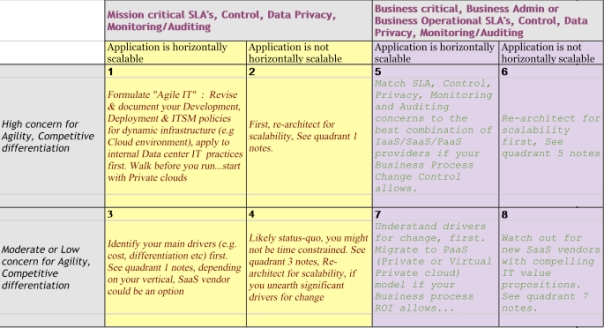I recently came across Benjamin Black’s blog on complexity in the context of AWS. He says:
i now see complexity moving up the stack as merely an effect of complexity budgets. like anything worth knowing, complexity budgets are simple: complexity has a cost, like any other resource, and we can’t expect an infinite budget.
spending our complexity budget wisely means investing it in the areas where it brings the most benefit (the most leverage, if you must), sometimes immediately, sometimes only once a system grows, and not spending it on things unessential to our goals.
What drives design complexity, in the Cloud computing infrastructure space?
Finding the right mix of functional “differentiation” versus “integration” at all levels or tiers of the design (whether it is hardware or software), along with technology & business constraints drive “complexity budget”.
“Differentiation” at the functional level is pretty well understood, but evolving: Routers, Switches, Compute, Storage nodes although the very basis of how these functions are realized is changing (e.g. Cisco is supposed to be gearing to sell servers).
“Integration” of various infrastructure functions in the data center, is always a non-trivial system (integration) expense.
Some Technology constraints examples:
- Right from the chip level to system level, energy efficiency improvements are much slower than, hardware density improvements. Consequently, not being able to consume power in proportion to utilization levels result in sub-optimal cost/pricing structures.
- Context/environment for virtualization for Cloud providers is really around defining what it means to have a “virtualized data center”. Cisco’s Unified computing being one example.
- Workload characterization & technology mapping
Business constraints: typically, learning curve/market adoption, cost and time-to-market.
The need to produce manageable systems, the imperatives of interdependencies from the chip level to board, system level, software and ultimately the data center level requires us to resort to holistic, iterative thinking & design: We have to consider the function, interaction at all levels, in the context of the containing environment, i.e. what it means to have a “fully virtualized” data center.
Ironically, Virtualization gets more attention than “Reconfigurability” needed (in response to virtualization, workload & utilization variations) at all levels: compute, storage, interconnect, power/cooling, perhaps even topology with in the data center.
After all, Cloud providers would want:
- “proportional power consumption” at the data center level
- reduced system integration costs with fully integrated (virtualization aware) compute, storage & interconnect stack
- optimal cloud computing operations, even for non-virtualized environments (lets face it, there are tons of scenarios that don’t necessarily need virtualization; by the same token, there are virtualization solutions that enable better utilization but don’t require hypervisors).
- complete automation of managed IT environments
This is all about moving the complexity away from IT customers (adopting the cloud computing model), and in to the data centers/cloud providers.
